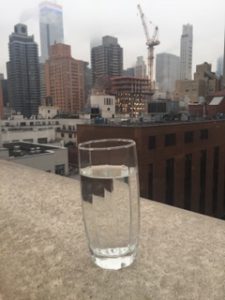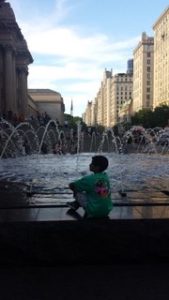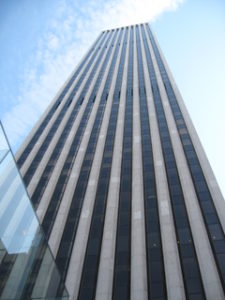
New York City’s drinking water is considered to be among the best in the world. Photo courtesy of E.B. Pupke
Restoring and Protecting Natural Filters: NYC’s Creative Solution for Clean Water
Restoring and protecting natural filters in the environment was the solution
It is a complex system. Delivering clean water to a city of 8.6 million residents requires a great deal of planning and engineering. But in New York City, the most critical component of their water works system maybe the simplest: restoring and protecting natural filters found in New York’s water system.
The System: Reservoirs, lakes, aqueducts
A system of nineteen reservoirs and three lakes that are generally located in the rural Catskills region north of the city provides 1.2 billion gallons of water daily. The water travels as much as 125 miles through aqueducts and tunnels to the city. This system began providing water in 1842. It has been expanded many times since with large expansions in the 1930’s, 1940’s, 1950’s and 1960’s. Today it provides water to New York’s more than 3 million housing units and 1 million businesses.
The water this system produces is often considered among the best water of any city in the world. Generations of New Yorkers have enjoyed a simple system that provides clean water directly to their residences and businesses. Historically, the water from Upstate New York has been so clean that the city did not have to filter it before it reached faucets.

Reservoirs in the Catskills Mountains region of Upstate New York provide water to New York City. When threatened by pollution that would have cost $10 billion to address, the City went after the source of the pollution and in the process saved billions of dollars and helped restore and protect habitat for a wide diversity of wildlife. Photo courtesy Chris Pupke
The Problem: High cost of filtration plants
Unfortunately, pollution has developed into a threat to the pristine water New Yorkers have taken for granted. By the early 1990’s the Environmental Protection Agency (EPA) and New York State’s Department of Health (NYDH) demanded that the City take steps to protect its water supply. Plans were developed for a filtration plant that would for the first time treat the city’s water supply from the Catskills. The plant would cost $10 billion to construct and another $100 million to operate annually. This extraordinary cost would be borne by the city’s tax payers. And this is where the simplicity overtook the planning effort.
Related: Water Quality at Dixie Drain Facility
City engineers thought that rather than treat water after it gets polluted, the pollution should be prevented from ever fouling the city’s water supply in the first place. This approach led to the development of a plan that would yield green benefits twice –both financial and environmental.
The Solution: Restoring and Protecting Natural Filters
The plan laid out an aggressive approach to pollution prevention, addressing the most serious pollution generators in the reservoir watersheds. Every five years the City has revised the plan that needs EPA and NYDH approval (a Filtration Avoidance Determination- FAD). These FAD’s allow New York City to avoid the construction of a filtration plant for water from its reservoirs in the Catskills region. The City’s plan includes a broad suite of options to address potential sources of pollution.
The City protects (either through fee simple acquisition or conservation easements) hydrologically sensitive property. The City notes that this approach “serves a number of important water quality functions: maintaining natural features that filter pollutants before they reach reservoirs; precluding land uses that would otherwise introduce new pollutants into the water supply; and shifting development toward areas of less sensitivity.” Acquisition plans focus on properties that have streams, wetlands and floodplains. Between 1997 and 2013, the land acquisition program had protected 130,000 acres of land through acquisition or conservation easement. This was accomplished in partnership with almost 1,500 voluntary landowners.
Best management practices to restore and protect a watershed
The plan also calls for experts to provide farmers in the watershed with advice on best management practices (BMPs) for their agricultural operation. Whole Farm Plans have been developed on almost 400 farms resulting in the implementation of more than 5,000 BMP’s. BMP’s are practices that help reduce pollution, such as nutrients and sediment, generated from farms. These practices include riparian buffers (vegetated plantings along waterways and ditches), nutrient management plans, manure storage, and the elimination of harmful agricultural practices. Recent reports stated that more than 2,000 acres of forested riparian buffers had been planted in these watersheds.
Enjoy more by Chris Pupke: Horseshoe Crabs and Relationships are Worth Working On
Programs have also been developed for forest owners, owners of stream-side properties, and even homeowners. The forestry and stream-side programs provide management advice for landowners about the best methods to reduce pollution generated from these properties. Homeowners are eligible for help with improvements to their septic systems that reduce the amount of nutrients and dangerous bacteria fouling the watersheds.

Among the best management practices that New York City implements to provide clean water to buildings like the General Motors Building in midtown Manhattan is the planting of more than 2,000 acres of forested riparian buffers to restore and protect this natural filter.
The cost for this simple approach is $1 billion, saving the city $9 billion. And it also provides benefits for wildlife that enjoy the new habitat established and old habitat protected by this program.
Conclusion: Natural filters provide great value
New York City demonstrated that it is cheaper to prevent pollution than to treat pollution. This simple truth is too often ignored by society to the expense of its tax payers and the environment. New York City’s water system reminds us of the tremendous value nature provides us – value that is under-appreciated and often forgotten. It reminds us that by restoring the natural world we provide great value to ourselves too.
Sources:
Hu, Winnie; “A Billion Dollar Investment in New York’s Water”; New York Times; January 18, 2018; https://www.nytimes.com/2018/01/18/nyregion/new-york-city-water-filtration.html
“New York City Filtration Avoidance Determination”; Environmental Protection Agency, New York State Department of Health; 2017 Surface Water Treatment Rule Determination for New York City’s Catskills/Delaware Water Supply System; December 2017.
http://www.nyc.gov/html/dep/html/watershed_protection/agriculture.shtml
http://www.nyc.gov/html/dep/html/drinking_water/history.shtml
http://www.nyc.gov/html/dep/html/watershed_protection/land_acquisition.shtml
http://www.nyc.gov/html/dep/html/watershed_protection/septic_systems.shtml
https://www.nycwatershed.org/about-us/success-stories/conservation-easements/crep-2011-accomplishments/

Recent Comments